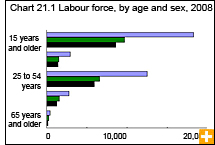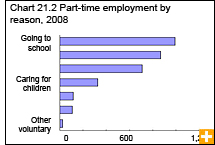Common menu bar links
Labour
Archived Content
Information identified as archived is provided for reference, research or recordkeeping purposes. It is not subject to the Government of Canada Web Standards and has not been altered or updated since it was archived. Please contact us to request a format other than those available.
In 2008, the labour force grew at an annual rate of 1.7%, bringing the total number of people in the labour force to 18.2 million. Since peaking at 2.9% in 2002, the labour force grew by 1.6% on average over the last six years.
The employment rate—the number of people employed expressed as a percentage of the population aged 15 and older—edged down slightly in 2008, ending in December at 63.1%. This pushed the unemployment rate—the proportion of unemployed people in the labour force— up to 6.6% in December, compared with 5.9% the previous year.
The highest employment rates in 2008 were observed in Western Canada, particularly in Alberta (72.0%), Saskatchewan (66.8%), and Manitoba (66.7%).
During the last quarter of 2008, the labour market experienced some tightening as economic growth slowed. The hardest-hit sectors were agriculture, construction and manufacturing. Employment levels in those three sectors fell by 216,000 during the last quarter alone (from October to December), after gaining 317,000 in the first three quarters of the year.
The participation rate—the percentage of those aged 15 and older who had a job or were looking for one—fell to 67.6% in December from a peak of 67.9% in May, as the labour force contracted toward the end of the year.
Earnings rose
Despite employment losses, employees’ average weekly wages rose 4.0% in 2008. Wages in the construction sector saw above-average growth, increasing 6.9% to $965.26; agricultural wages grew 5.2% to $543.98 on average. In manufacturing, average weekly wages grew 4.0% to $894.24, the slowest growth of all three sectors.
The most prevalent occupations for women in 2008 were in sales and service occupations, such as retail sales people and sales clerks, cashiers, and cleaners and janitors; business, finance and administrative occupations, including secretaries and clerks; occupations in social science, education, government, service and religion, such as teachers and social workers; health occupations, including nurses and technicians; and management occupations, such as managers in retail, food and accommodation.
Men worked primarily in trades, transport and equipment operation and related occupations—mainly the construction trades, such as contractors and machinists; in sales and service occupations—primarily wholesale, retail and protective services, such as cleaners and janitors; in management occupations—mainly in retail trade, food and accommodation services; in natural and applied sciences and related occupations—mainly in professional and technical occupations; and in business, finance and administrative occupations.




